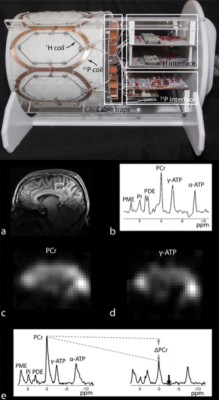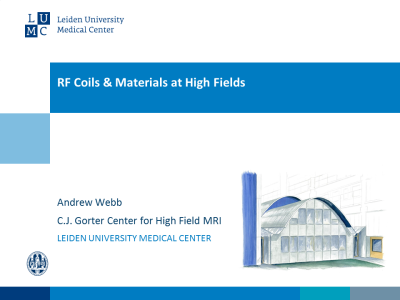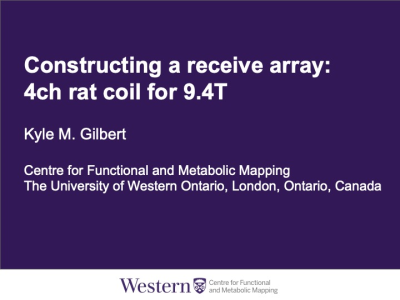RF Coils
RF Coils
Weekend Course
Weekend Course
ORGANIZERS: Gregor Adriany, Mary McDougall
Sunday, 12 May 2019
| Room 516AB | 08:00 - 16:00 | Moderators: Greig Scott, Manuela Rösler |
Skill Level: Intermediate
Session Number: WE-15AB
Overview
In this one-day course, the principles of RF coils used to detect and excite MR signals will be discussed, beginning with the transmission lines that interconnect the coils to the MR system and extending to single-surface and volume coils and finally RF coil arrays for both transmit and receive. A discussion of the RF modeling tools used to analyze these coils and coil arrays and their interaction with the patient and the environment will lead into the interaction of RF fields with other objects in the MR environment. The course will conclude with a live demonstration of array coil construction. Attendees will receive relevant session and talk recommendations from the speakers.
Target Audience
This course is designed for MR technicians, scientists, and engineers with an interest in understanding the principles behind the construction, design, and use of RF coils and RF coil arrays.
Educational Objectives
As a result of attending this course, participants should be able to:
-Describe the basic theory, design, and construction of single and multi-tuned RF coils and their feed networks;
-Illustrate the principles of operation and basic applications of receive and transmit RF coil arrays; and
-Compare and contrast the major methods of RF modeling commonly in use and the relative advantages and disadvantages of each.
Overview
In this one-day course, the principles of RF coils used to detect and excite MR signals will be discussed, beginning with the transmission lines that interconnect the coils to the MR system and extending to single-surface and volume coils and finally RF coil arrays for both transmit and receive. A discussion of the RF modeling tools used to analyze these coils and coil arrays and their interaction with the patient and the environment will lead into the interaction of RF fields with other objects in the MR environment. The course will conclude with a live demonstration of array coil construction. Attendees will receive relevant session and talk recommendations from the speakers.
Target Audience
This course is designed for MR technicians, scientists, and engineers with an interest in understanding the principles behind the construction, design, and use of RF coils and RF coil arrays.
Educational Objectives
As a result of attending this course, participants should be able to:
-Describe the basic theory, design, and construction of single and multi-tuned RF coils and their feed networks;
-Illustrate the principles of operation and basic applications of receive and transmit RF coil arrays; and
-Compare and contrast the major methods of RF modeling commonly in use and the relative advantages and disadvantages of each.
| 08:00 |
 |
Basics of RF Theory, Transmission Lines & Power Transfer
Steven Wright
This talk will cover the basics of RF transmission lines and wave guidance. While two-conductor transmission lines are ubiquitous in MRI today, other forms of wave guidance are becoming increasingly popular with the emergence of high and ultra-high field MRI systems. An electromagnetic approach to transmission lines, as opposed to a circuit-theory approach, covers all cases. The talk will discuss the Smith Chart, applications of transmission lines beyond interconnects, and discuss practical issues of transmission line selection.
|
| 08:30 |
Volume & Surface Coils
Özlem Ipek
This talk will cover the basic theory and design of a RF coil, characterization of the RF coil on the bench including tuning, matching and quality factor with a vector network analyzer, on the scanner with B1 maps and signal-to-noise ratio measurements and electromagnetic field simulations. Various types of RF coils as well as the recent RF coil concepts will be addressed.
|
|
| 09:00 |
 |
Multi-Tuned Coils
Ryan Brown
· Dual-tuned coils provide metabolic information (x-nuclei module) and co-registered anatomical images and B0 shim settings (1H module) without repositioning the subject or coil
· X-nuclei signal strength is typically less than 1/1,000× that of 1H (1). Therefore it is important to maximize x-nuclei receive sensitivity while simultaneously providing adequate 1H sensitivity · We will discuss prevalent dual-tuning techniques and considerations for performance characterization and interfacing dual-tuned coils |
| 09:30 |
Break & Meet the Teachers | |
| 10:00 |
 |
Receive Arrays & Circuitry
Arne Reykowski
Transmit antennas are typically design with a strong focus on homogeneity. In contrast, receive antennas (also referredto as local coils) are optimized for high signal-to-noise ratio (SNR) within a certain region of interest (ROI) andtypically do not offer homogeneous sensitivity.
|
| 10:30 |
 |
Transmit Arrays & Circuitry
Roberta Frass-Kriegl, Sigrun Goluch-Roat, Lena Nohava, Michael Pichler, Elmar Laistler
RF transmission in MR measurements relies on RF coils, the transmit system (typically part of the MR scanner), and RF pulse design. In this educational presentation, basic principles of transmit coil arrays and related circuitry will be explained for single channel as well as multi-channel transmit systems. The potential of static B1+ shimming and full parallel RF transmission will be discussed including the aspect of more complicated safety evaluation in terms of specific absorption rate (SAR) with increased degrees of freedom.
|
| 11:00 |
RF Modeling
Bastien Guerin
In this talk, I will present the basics of the three main electromagnetic simulation approaches for assessment of MRI RF coils: finite difference time domain, finite element modeling and integral equations. The strengths and weaknesses of these techniques will be compared. I will introduce the co-simulation approach to fast coil analysis. Finally, I will talk about the availability of body models for each technique as well as major applications such as RF coil safety assessment, design optimization and calculation of ultimate metric bounds.
|
|
| 11:30 |
Lunch & Meet the Teachers | |
| 13:30 |
 |
RF Coils & Materials at High Fields
Andrew Webb
This talk concentrates on the similarities and differences in designing RF coils for high field MRI. In particular the effects of sample loading, coil losses, coil decoupling, travelling wave effects and near field/far field effects are considered. Examples of loop, dipole and combined loop/dipole configurations are shown. Finally the role of high permittivity materials, alone or in combination with high field MRI coils is discussed.
|
| 14:00 |
Emerging Technologies: Flexible, Lightweight, Optical & Wireless
Fraser Robb
Phased coil arrays have changed dramatically since their earliest inception with increasing complexity and channel density. These changes have led to the development of an innovative fully flexible coil design with highly integrated electronics, which can be placed easily within todays modern coil arrays to reduce the design complexity associated with the large number of channels. Recently, research has been done to improve the interface between RF coils and MRI systems by transferring the data over wireless or optical connections within the scanner bore. The evolution of all of these new technologies can provide a fully wireless, or lightly tethered, future for coil arrays and allow potential the realization of a patient-friendly phased array.
|
|
| 14:30 |
Break & Meet the Teachers | |
| 15:00 |
 |
Live Construction of Receive Arrays
Kyle Gilbert
This course will focus on the construction of a four-channel receive array for small-animal imaging at 9.4 T. Although this demonstration is geared toward a specific application, the construction methods are applicable to receive arrays for both humans and animals, and with any number of elements. The demonstration will cover the basic steps of constructing a receive array: the design of a former, tuning and matching, preamplifier decoupling, active detuning, geometric decoupling, and cable management. This course is intended for the student, technician, or researcher who wants to learn the basic steps on how to build a receive array.
|
| 15:00 |
Live Construction of Receive Arrays
Omer Oran
|
|
| 16:00 |
Adjournment & Meet the Teachers |
 Back to Program-at-a-Glance |
Back to Program-at-a-Glance |  Back to Top
Back to Top